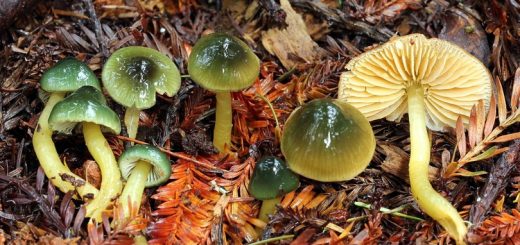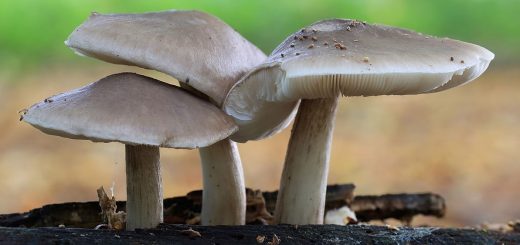#052: The Indigo Milk Mushroom, Lactarius indigo
After discussing a few mushrooms you should avoid, I thought you deserved to hear about one of my favorite edible mushrooms. Lactarius indigo has a good flavor, but what really makes this mushroom enjoyable is its color. As you can guess from its name, indigo is blue. Blue mushrooms are fairly rare, so they are always fun to find. This beautiful mushroom is also edible, making it one of the few naturally blue foods. Most bluish foods – such as blueberries – are actually reddish-purple. I have enjoyed this mushroom grilled with some seasoning, but there are other ways prepare it. One of the more festive options is to cook it with scrambled eggs. This, as you may guess, gives you green eggs (without needing any food coloring*)!
Lactarius indigo is placed in the phylum Basidiomycota, class Agaricomycetes, order Russulales, and family Russulaceae. Like the other members of its genus, the Indigo Milk Mushroom exudes milky latex when cut. In this medium-sized to large (5-15cm) mushroom, the latex is a deep blue color and dries greenish. It usually does not produce much latex, so the fluid may only be noticeable as a darkening at the site of injury. This mushroom exhibits a number of features characteristic of the Russulaceae: the forked gills are attached to the more or less central stipe or run down it slightly; its cap is convex when young and becomes flat to funnel-shaped in age; the margin of the cap is curled inward when young. Many Lactarius species (including L. indigo) have a zonate cap, which is characterized by alternating bands of lighter and darker colors. Members of the Lactarius genus also tend to form hollow stipes that develop “potholes” on the surface as they age. There are a few look-alikes to the Indigo Milk Mushroom, but all of those are edible. L. indigo var diminutivus is exactly like L. indigo but is smaller (cap 3 to 4cm wide). L. paradoxus is grayer and exudes red latex when cut. Remember: always identify mushrooms you collect for the table down to species. L. indigo is rare but widely distributed east of the Rocky Mountains. It can be found fruiting under conifers and hardwoods summer through fall.
*If you want to have some green ham with your green eggs, I would not recommend any naturally-occurring green ham. That ham would probably make you sick. So you will have to use food coloring if you want to complete the Seussian ensemble.

![#122: Sphaerobolus stellatus, the Artillery Fungus [Archived]](https://www.fungusfactfriday.com/wp-content/themes/hueman/assets/front/img/thumb-medium-empty.png)







![#011: Characteristics of Kingdom Fungi [Archived]](https://www.fungusfactfriday.com/wp-content/themes/hueman/assets/front/img/thumb-small-empty.png)

1 Response
[…] and drip to the ground. On the other end of the spectrum, there are mushrooms like L. indigo (FFF#052), which produce only enough latex to make the injured area tacky.3 The amount of latex produced […]